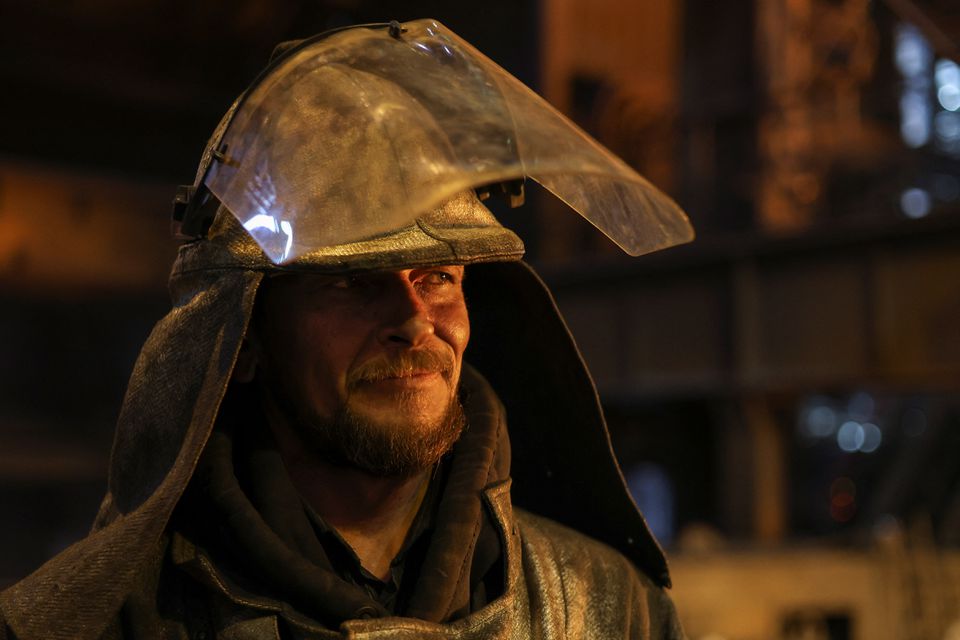Zaporizhstal, a steel plant in the southern Ukrainian city of Zaporizhzhia, has managed so far to keep running in defiance of staff shortages, blocked exports, power blackouts and the threat of Russian missile attacks.
It shut down temporarily last year for the first time since World War Two. Its general director Roman Slobodianiuk knows that the future of the plant and Ukraine's mighty steel industry more broadly, is in doubt.
Until producers can get steel to markets via the Black Sea, where Russia continues to pose a threat to shipping, there is little prospect of recovery for a sector second only to agriculture in its importance to Ukraine's economy.
"If we do not have open sea ports, our industry will not survive, and all other industries will follow us," Oleksandr Kalenkov, the president of the Ukrmetalurgprom enterprises’ association, told Reuters.
The association's statistics explain the assessment. In Soviet times, Ukraine produced more than 50 million tonnes annually. That fell to 21-22 million tonnes by 2021, and after Russia invaded last year, production hit 6.3 million in 2022.
The slump is explained in part by Russia's territorial gains that have led to the loss of control over, or destruction of giant plants, notably in Mariupol. It was at Azovstal steelworks where some of the fiercest fighting of the war took place.

REUTERS / Oleksandr Ratushniak
In the first nine months of 2023, production was down a further 17% year-on-year at 3.9 million tonnes, the latest data shows, although the full-year figure could show a modest rise.
Another small bright spot is domestic demand, which is rising as Ukraine churns out more weapons, builds bomb shelters and begins to rebuild towns and cities damaged during the war.
But even with consumption nearly doubling to 2.6 million tonnes between January and September, that is not enough to sustain a sector that used to export four fifths of its output.
Before the full-scale invasion, the mining and metallurgical complex as a whole accounted for 10% of Ukraine's GDP and 30% of exports.
Trains and ships
With Black Sea shipments virtually non-existent, steelmakers are sending as much produce via rail to Europe as they can.
Of the 1,800 cargo cars that move from Ukraine to Europe each day, the steel industry accounts for about half, and the limit for rail exports is around 3 million tonnes a year.
"If you compare it to seaborne transport, it costs four times more," Slobodianiuk told Reuters during a visit to the plant earlier this month. He added that this year cargo rail tariffs would increase, pushing up cost by another 20-30%.
Meanwhile, less than 100,000 tonnes of steel have moved through southern ports around Odesa so far in 2023, said Stanislav Zinchenko, head of Ukrainian commodities think-tank GMK Center, a tiny percentage of what is needed.
Zaporizhstal expects to export two thirds of its 2.4-2.5 million tonnes of iron ore and rolled steel production in 2023. Before the invasion, output of the plant was 4.2 million tonnes a year.
Kyiv is beginning to move cargoes through what it calls a "humanitarian corridor" hugging the coasts of Ukraine, Romania and Bulgaria and on through Turkey, after Russia pulled out of a grain deal whereby it agreed not to attack vessels carrying agricultural products.
Steel officials and executives hope steel could also use the route. However, it is risky given the war raging in Ukraine and the Black Sea, and Russia has increased attacks on port infrastructure in and around Odesa in recent weeks.
Power cuts, staff in Armed Forces of Ukraine
Beyond restricted exports, steelworks have struggled to find employees, even though they are running at reduced capacity.

REUTERS / Oleksandr Ratushniak
Several hundred Zaporizhstal employees left the city at the beginning of the war due to Zaporizhzhia's proximity to the frontlines only 50 km (31 miles) away, and to Europe's largest nuclear power plant that is under Russian control.
Another 1,050 went to serve in the Armed Forces of Ukraine, 40 of whom have been killed, Slobodianiuk said.
Overall, the plant has lost 20% of its pre-invasion workforce of around 10,000, he added.
"We are at the maximum of our output capability because of the number of people," – Slobodianiuk added.
Steel roller Maksym Medkov said his section barely had enough people to carry on. About 20 students were being trained after 17 workers from the department left for army.
"People fall ill or have family issues, and then it becomes difficult," he told Reuters.
However, most workers Reuters spoken to at the plant said they were determined to carry on.
Oleksandr Yasunas, who at 23 looks out of place surrounded by soot-caked colleagues who have been working in the plant's vast blast furnaces since before he was born, plans to stay.
"All those who wanted to move away did it already," he said.
Irregular power supplies also threaten to cut production further just as winter approaches and pressure on the grid is at its height.
Last winter, Russia pounded the Ukrainian electricity system with hundreds of missiles and drones, damaging about 40% of the network. Some has to be repaired and temperatures have begun to drop, driving power demand higher.
"We can say that blackouts last winter reduced steel production by two to three times," Zinchenko said, citing production data for the months when blackouts were most regular.
